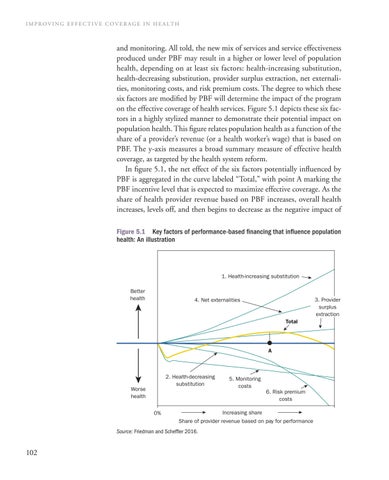IMPROVING EFFECTIVE COVERAGE IN HEALTH
and monitoring. All told, the new mix of services and service effectiveness produced under PBF may result in a higher or lower level of population health, depending on at least six factors: health-increasing substitution, health-decreasing substitution, provider surplus extraction, net externalities, monitoring costs, and risk premium costs. The degree to which these six factors are modified by PBF will determine the impact of the program on the effective coverage of health services. Figure 5.1 depicts these six factors in a highly stylized manner to demonstrate their potential impact on population health. This figure relates population health as a function of the share of a provider’s revenue (or a health worker’s wage) that is based on PBF. The y-axis measures a broad summary measure of effective health coverage, as targeted by the health system reform. In figure 5.1, the net effect of the six factors potentially influenced by PBF is aggregated in the curve labeled “Total,” with point A marking the PBF incentive level that is expected to maximize effective coverage. As the share of health provider revenue based on PBF increases, overall health increases, levels off, and then begins to decrease as the negative impact of Figure 5.1 Key factors of performance-based financing that influence population health: An illustration
1. Health-increasing substitution Better health
3. Provider surplus extraction
4. Net externalities
Total
A
2. Health-decreasing substitution
Worse health
5. Monitoring costs
6. Risk premium costs
Increasing share
0%
Share of provider revenue based on pay for performance
Source: Friedman and Scheffler 2016.
102

